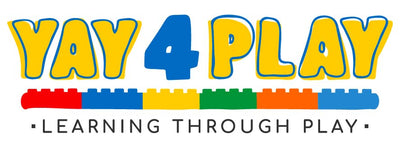Choosing the perfect resources for your school can be a challenging task, but it doesn't have to be.
Read more to learn about practical tips and insights to help teachers in early learning centres, family day cares, and primary schools (K-1) select versatile, budget-friendly resources that emphasize learning through play throughout the school day.
For more ideas, resources and powerful teaching tools, visit Yay4Play.

The Power of Play-Based Learning
Play-based learning is more than just fun—it's a critical part of child development.
Research shows that play enhances cognitive abilities, fosters social and emotional growth, and encourages creativity and problem-solving skills.
By integrating play into the classroom, teachers can create an engaging and effective learning environment.
Key Benefits of Playful Learning:
The right resources provide opportunities for active learning and the development of core learning skills:
- Enhances cognitive development
- Builds social skills and teamwork
- Promotes physical skills
- Encourages creativity and imagination
- Helps develop perceptual skills
- Builds emotional skills
- Promotes maths exploration
- Helps with social interaction and groupwork
- Provide hand-eye coordination games
- Develops mental readiness.
All in all, these hands-on learning tools help childhood educators and primary teachers to create amazing learning opportunities for their class.

Criteria for Choosing Educational Resources
Educational Value:- Ensure the resources have clear educational objectives.
- They should be part of curriculum goals and enhance the learning experience.
- They should also support various aspects of holistic child development.
- Opt for resources that can be used in multiple ways.
- Versatile materials save money and space while offering varied learning opportunities.
- They also support skills development in a flexible and practical way.
- Choose high-quality, durable materials for classroom activities that can withstand frequent use for experiential learning as well as explorative learning.
- Stick to your budget by prioritising essential activity resources.
- Look for deals or bulk purchasing options that are appropriate for classroom practice.

Top Educational Resources for Early Learning
- Building Blocks and Bricks:
- LEGO® and DUPLO® type bricks: These powerful teaching tools are fantastic for developing fine motor skills, communication games, and problem-solving abilities as part of the basic education journey. Visit Yay4Play for innovative ideas using these blocks.
- Sensory Play Materials:
- Playdough, Sand, and Water Tables: Sensory materials help children explore textures and develop their senses. Even the bricks themselves as a hands-on resource lend themselves to this type of exploration.
- Storytelling Kits:
- Build-a-Book Series: This hands-on, immersive reading experience combines the joy of building with the magic of storytelling. These form part of any childhood education curriculum as they are ideal for fostering literacy and creativity. Find more about this amazing resource at Yay4Play.
- Educational Games:
- Board Games and Card Games: Games like memory match, counting games, and word puzzles enhance cognitive skills and are great for group activities and skills development.

Practical Tips for Implementing Educational Resources to create an engaging learning environment
- Integrate Play into Daily Routine: Incorporate play into the daily schedule to make learning fun and engaging. And, of course, to emphasise all aspects of child development.
- Encourage Independent and Group Play: Provide opportunities for both independent and group play so that you notice improvements in emotional development and in boosting elements of vocabulary development.
- Create a Stimulating Environment: Design your classroom to be a stimulating environment where children can explore and learn.
- Engage with Parents: Communicate with parents about the importance of play-based learning and how they can support it at home. Doing some simple brick activities at home for example would embed deeper exploration of some of the key skills.
Budget-Friendly Tips
- DIY Resources: Create your own educational materials using everyday items.
- Collaborate with Other Teachers: Share resources and ideas with other teachers.
- Select versatile tools: An example of this is that there are over 200 Six Bricks activities – same set of colourful bricks allows you to use them all year round.

The Research Behind Yay4Play's Resources
We believe in selecting classroom resources that are grounded in research and substantial theory.
At Yay4Play, our resources are based on extensive research into the benefits of learning through play, drawing from the theories of Seymour Papert and constructionism.
Papert's ideas emphasize the importance of play in the learning process, making it clear that play-based activities are essential for effective education.
The Six Bricks Method
The Six Bricks method is a perfect example of how we incorporate these principles. This innovative method uses six LEGO® DUPLO® type bricks to create activities that promote learning through play.
Here's why Six Bricks is so versatile and effective:
- Educational Value: Each activity meets specific learning objectives.
- Versatility: Suitable for a wide range of learning activities.
- Durability: High-quality, durable materials.
- Budget-Friendly: Cost-effective solution offering high educational value.
- Engagement: Keeps children engaged and motivated to learn.
For more on the Six Bricks method, visit Yay4Play.
Conclusion – find the best class kits for your school!
Choosing the best educational resources is crucial for fostering a love for learning and supporting holistic development in children.
By focusing on play-based, versatile, and budget-friendly resources, you can create an engaging and effective learning environment.
Visit Yay4Play for more ideas and resources.
